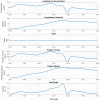LSTM-Based Virtual Load Sensor for Heavy-Duty Vehicles
- PMID: 38203088
- PMCID: PMC10781386
- DOI: 10.3390/s24010226
LSTM-Based Virtual Load Sensor for Heavy-Duty Vehicles
Abstract
In this paper, a special recurrent neural network (RNN) called Long Short-Term Memory (LSTM) is used to design a virtual load sensor that estimates the mass of heavy vehicles. The estimation algorithm consists of a two-layer LSTM network. The network estimates vehicle mass based on vehicle speed, longitudinal acceleration, engine speed, engine torque, and accelerator pedal position. The network is trained and tested with a data set collected in a high-fidelity simulation environment called Truckmaker. The training data are generated in acceleration maneuvers across a range of speeds, while the test data are obtained by simulating the vehicle in the Worldwide harmonized Light vehicles Test Cycle (WLTC). Preliminary results show that, with the proposed approach, heavy-vehicle mass can be estimated as accurately as commercial load sensors across a range of load mass as wide as four tons.
Keywords: long short-term memory; mass estimation; recurrent neural network.
Conflict of interest statement
The authors declare no conflict of interest.
Figures











References
-
- Xu C., Geyer S., Fathy H.K. Formulation and comparison of two real-time predictive gear shift algorithms for connected/automated heavy-duty vehicles. IEEE Trans. Veh. Technol. 2019;68:7498–7510. doi: 10.1109/TVT.2019.2921702. - DOI
-
- Chen Y.L., Shen K.Y., Wang S.C. Forward collision warning system considering both time-to-collision and safety braking distance; Proceedings of the 2013 IEEE 8th Conference on Industrial Electronics and Applications (ICIEA); Melbourne, Australia. 19–21 June 2013; pp. 972–977.
-
- Ritter A. Ph.D. Thesis. ETH Zurich; Zurich, Switzerland: 2021. Optimal Control of Battery-Assisted Trolley Buses.
-
- Kober W., Hirschberg W. On-board payload identification for commercial vehicles; Proceedings of the 2006 IEEE International Conference on Mechatronics; Budapest, Hungary. 3–5 July 2006; pp. 144–149.
-
- Technoton Axle Load Sensors. 2023. [(accessed on 26 November 2023)]. Available online: https://jv-technoton.com/products/axle-load-sensors/
LinkOut - more resources
Full Text Sources

